Abstract
TiN thin films are widely used as protective and decorative coatings for tools in industry. Previous studies have focused on the deposition of TiN coatings on substrates by reactive magnetron sputtering, whereas the use of TiN targets avoids problems such as ‘nitrogen contamination’ and ‘target poisoning’. TiN coatings were grown on silicon wafers and cemented carbide substrates by varying the parameters of the magnetron sputtering plasma source, operating Ar pressure and deposition temperature. The experimental results show the better mechanical properties of ceramic materials deposited using radio frequency (RF) magnetron sputtering. During RF magnetron sputtering, the hardness of the coating increased significantly to 17 Gpa when the deposition working pressure was reduced from 1.5 Pa to 0.5 Pa. The coefficient of friction tends to decrease as the deposition temperature increases, and at 400 °C the coefficient of friction between the deposited film and the friction pair made of Al2O3 material is only 0.36. The nano-scratch experimental tests concluded that the TiN coatings deposited at 300 °C conditions had the best adhesion to the substrate at an Ar pressure of 0.5 Pa under an RF source.
1. Introduction
TiN films with a high hardness, good chemical stability, wear resistance and other characteristics are widely used for tool protection and as decorative coatings [,], one of the earliest applications in cutting tool coatings of binary coating materials. The deposition of TiN coatings on the working surfaces of forming tools made of high-speed steel (HSS) and tungsten–cobalt (WC), tungsten–titanium–cobalt (WC-TiC) and tungsten–titanium–tantalum–cobalt (WC-TiC-TaC), and other cemented carbide materials, reduces the wear of the tools and prolongs their service life []. At the same time, TiN coatings prepared under certain parameter conditions show a golden yellow colour, which is clearly recognisable in the machining tool library [,].
TiN coatings are mainly prepared by chemical vapor deposition (CVD) and physical vapor deposition (PVD). High deposition temperatures tend to cause the outward diffusion of the Co-bonded phase in the cemented carbide [,,,], and secondary annealing or quenching affects the mechanical properties of the substrate [], all of which limit the application of CVD technology to tool coatings.
Magnetron sputtering, as a PVD technology, is characterised by a low deposition temperature, the dense and homogeneous adhesion of the prepared films and a fast deposition rate [,,]. At present, most researchers have prepared TiN coatings by reactive magnetron sputtering [,,,]. However, this preparation method suffers from the following defects: (i) The properties of TiN coatings are strictly required for the N2 flux. With the fluctuation in the N2 flux, there are differences in the atomic proportions of the microscopic regions of the generated films, i.e., the generated compounds are TiNx [,]. F. Vaz [] has reported that when the N2 flux is less than 3 sccm, the prepared coatings mainly consist of the hcp α-Ti metal lattice. With an increase in the N2 flux, the N atoms enter the α-Ti lattice in a gap-filling manner, forming a non-metallic sublattice, but there are few covalent bonds between Ti and N, so the TiNx mainly exhibits metallicity. When the N content is in the range of 20–30 at.%, the coating exhibits a light yellow colour, but the coating is mainly composed of the transition compound ε-Ti2N phase structure. And with a further increase in the N content, the coating is transformed to the fcc δ-TiN phase. (ii) It is well known that hysteresis phenomena and arc effects tend to affect film quality during reactive magnetron sputtering processes. (iii) In commercial applications or experimental research, coating equipment typically provides multiple functions. For example, the preparation of nitride multilayer films requires the periodic feeding and discharging of N2 [,,,], and if N2 as a reaction gas cannot be pumped out in time, it can easily react with other gases or targets, resulting in ‘nitrogen contamination’ that affects the experimental results and equipment components. The use of stoichiometrically proportioned TiN targets for the preparation of TiN coatings offers the possibility of solving these problems. However, there are few reports on the use of TiN targets for the preparation of tool protection layers. Exploring the mechanical properties of coatings deposited using TiN targets under different process parameters is a point of urgent research.
In this work, we used TiN targets with a precise stoichiometric ratio (the atomic percent ratio of Ti/N to be observed, approximately 1) to deposit protective coatings. Our study is divided into three mutually progressive steps, as illustrated in Figure 1. Three independent variables were systematically controlled to investigate the influence mechanism of process parameters on thin film deposition. (i) Sputtering mode: Under identical process conditions, the properties of TiN coatings deposited by DC magnetron sputtering and RF magnetron sputtering were comparatively analysed. (ii) Ar gas pressure: For RF sputtering deposition, the effects of Ar gas pressure (1.5 Pa vs. 0.5 Pa) were examined. (iii) Temperature dependence: The effect of deposition temperature on the properties of TiN films was investigated using an RF magnetron sputtering system at 0.5 Pa Ar gas pressure.

Figure 1.
Schematic representation of coatings deposited using TiN targets under different current sources, Ar gas pressures and deposition temperature conditions.
2. Experiments
2.1. Equipment and Materials
Magnetron sputtering achieves target material deposition through interparticle energy transfer [,]. By rationally controlling the sputtering parameters, nanoscale-thickness films can be prepared [,]. The experiment utilised an MSP-300B magnetron sputtering coater (Chuangshiweina Technology Co., Ltd., Beijing, China), where substrates served as the anode and the cathode held the target, with high-energy argon ions generated via gas discharge bombarding the target for sputtering [].
High-purity Ti (99.999%) and TiN (99.9%) targets (Φ 60 mm × 3 mm, ZhongNuo Advanced Materials Co., Ltd., Beijing, China) were employed in the experiments. The Ti target served as a transition layer to mitigate interfacial lattice mismatch between the film and substrates, while suppressing substrate-induced property variations, with both targets rigorously characterised to ensure chemical homogeneity and dimensional tolerance compliance prior to deposition [,]. The substrate materials and specifications selected for the experiment are shown in Table 1. YG8 represents cemented carbide, whose high strength and good impact toughness make the material widely used in the field of machining deep-drawing moulds [] and whose main components are hard-phase WC and the binder Co (Co = 8 wt.%). Inserts made of YG8 are usually used for the roughing and semi-finishing of uneven surfaces and the drilling and reaming of general and deep holes [].

Table 1.
Experimental substrate material parameters.
2.2. Experimental Procedures
Cemented carbide substrates were ground to a mirror finish, followed by sequential ultrasonic cleaning in acetone and ethanol (10 min each) and deionised water (15 min) to remove surface contaminants and oxides [,]. The residual air in the deposition chamber has a large impact on the experimental results, and the researchers found that even with a trace amount of oxygen content (O = 1 at.%), the Ti-N chemical bond will be weakened due to the high electronegativity of oxygen, resulting in a subsequent decrease in the films’ hardness []. In order to reduce the influence of the residual gas on the experimental results, the sputtering chamber was evacuated to 7.5 × 10−4 Pa before deposition to reach a high vacuum level. All substrates were then allowed to be blown dry in an Ar gas atmosphere at a flow rate of 30 sccm. The sputtering power of the Ti target was set to 150 W, the DC plasma source was selected, the sputtering power of the TiN target was set to 120 W, and the sputtering time was set to 30 min and 120 min, respectively. We set the distance between the TiN target and the substrate to 95 mm and the distance between the Ti target and the substrate to 100 mm.
To ensure systematic documentation of the experimental conditions, Table 2 comprehensively summarises the process parameters for all the experimental groups, with each configuration assigned a unique numerical identifier to facilitate cross-group comparisons and reproducibility validation. Notably, glow discharge stability significantly deteriorated below 0.5 Pa, while pressures exceeding 1.5 Pa induced an abnormal coarsening of columnar grains, leading to performance degradation and loss of engineering applicability. And TiN coatings are widely used not only for cutting tools but also for moulds, aircraft engine blades, industrial decorative parts and other engineered systems. Different applications may focus on different aspects; for example, tool coatings are more concerned with wear resistance, while some decorative coatings are more concerned with production costs and simplified processes. In order to meet these different needs, some of the experiments were conducted at room temperature, which is informative for certain application scenarios where simplified processes are required.

Table 2.
Sputtering parameters for TiN coatings.
2.3. Coating Characterisation
The surface and cross-sectional micromorphology of the coatings was investigated using a Field-Emission Scanning Electron Microscope (FE-SEM) (model: Verios 460; manufacturer: FEI Corporation, Hillsboro, OR, USA). An Energy-Dispersive X-ray (EDX) analysis was conducted using the same FE-SEM instrument to determine the chemical composition of the samples. The characterisation of the physical phase and the determination of the crystallinity of the films was performed using an X-ray diffractometer (XRD), model Smart Lab 9 kw (Rigaku Corporation, Tokyo, Japan), and a scanning angle range of 30–80°.
Hardness (H) and Young’s modulus (E) were measured using a UNHT3 nanoindenter (Anton Paar Corporation, Graz, Austria) (max load: 50/100 mN) with a Berkovich indenter (apex angle: 65.03°, E = 1141 GPa, Poisson’s ratio = 0.07).
Coating–substrate adhesion was evaluated via an Anton Paar nano-scratch tester (Graz, Austria) (max normal load: 300 mN, loading rate: 0.19 mN/s).
Tribological performance was assessed using a TRB³ reciprocating tribometer (counterpart: Φ 12 mm Al2O3 ball) under ambient conditions (25 ± 1 °C, 50 ± 10% RH) with a 10 N load, 2 Hz frequency and 10 mm sliding distance.
3. Results and Discussion
3.1. Effect of Different Current Sources on Coating Properties
The morphology and XRD of TiN coatings grown under DC and RF current sources are shown in Figure 2. Figure 2e shows the macroscopic morphology of the prepared samples, which shows that the TiN films grown on the WC substrates are smooth and uniform in overall shape, but the colour of the coating is blackish under the DC source condition, while the coating are yellowish under the RF source condition. The samples in the two groups show different shapes of micro-morphology with an increase in magnification. The surface of the samples prepared under DC power supply conditions has obvious agglomerated particles, which range from a few to a dozen, agglomerating with each other to form larger agglomerates. The TiN pyramidal morphology promotes heterogeneous nucleation, refining grains to the nanoscale (average grain size < 100 nm). Simultaneously, the geometric interlocking effect of pyramidal particles strengthens the coating–substrate interfacial adhesion. These structural advantages synergistically improve the coating’s wear resistance, high-temperature stability and chemical durability. It can be clearly seen that there are obvious narrow cracks between the agglomerates, and these initial cracks are enlarged by force, leading to the overall peeling off of the coating, which severely limits the machining life of the coated tools []. S2 samples have some ‘pyramid’ or tri-angled cone-type sharp objects on the surface, and the ‘plough-cut effect’ during the cutting process causes scratches on the surface of the workpiece. The bottoms of the ‘pyramids’ are inlaid upon each other due to extrusion, which makes the coating denser than DC magnetron sputtering, but the TiN coating prepared under this parameter condition inevitably has some initial cracks and interspaces.
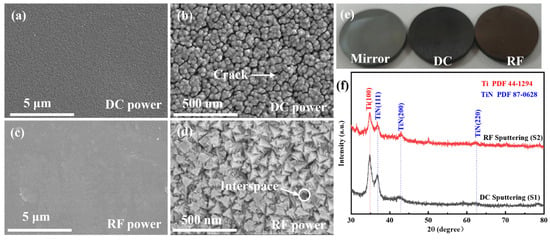
Figure 2.
Morphology and XRD patterns of TiN coatings deposited under DC and RF power sources. (a,b) show the surface morphology of DC-sputtered TiN coatings at low and high magnifications, respectively, (c,d) present the surface morphology of RF-sputtered TiN coatings at low and high magnifications, respectively, (e) compares the macroscopic surface morphology of the bare substrate and TiN coatings deposited under DC and RF sputtering modes, (f) displays the XRD patterns of TiN coatings synthesized under different sputtering modes.
In order to analyse the reasons for the different morphologies, Figure 2f shows the XRD patterns of the S1 and S2 samples. The non-dense nature of the coating results in a strong diffraction peak in the transition layer Ti (100). In all the mixed peaks of TiN, (111) exhibits a preferential orientation (PDF 87-0628), and in the TiN face-centred cubic structure, the preferential orientation of (111) is attributed to the lower strain energy of this face and a decrease in the TiN (111) peak under RF source conditions. The TiN coating prepared by the RF source shows a weaker (220) peak at 62.08°, which is related to the transition of the particles from an agglomerated structure to a ‘pyramidal structure’, in addition to possibly affecting the colour presented by the coating [].
The load–displacement curves of nanoindentation and their computational principles are shown in Figure 2a,b, where the H and E of the material can be obtained by the Oliver–Pharr (O&P) method []. In order to achieve a reasonable depth of penetration of the indenter into the coating, Figure 3c shows the cross-section topography of the DC magnetron sputtering sample. The thickness of the coating is approximately 2.5 μm, Ti transition layer can be clearly seen, the coating shows a clear columnar structure, and there are slight cracks on the surface of the columns. Figure 3d shows the nanoindentation curves of a TiN coating prepared by DC magnetron sputtering. With the number of indentation points being three, the maximum depth of indentation is not more than 800 nm; ‘pop in’ indicates that the depth appears to change abruptly when the load is not changed, which may be caused by the creep of the coating due to the indenter []. The average hardness of the coating is 1.35 GPa; Young’s modulus is 93.02 GPa. The hardness of the coating is 1.61 GPa when the current source is changed to the RF source under the same conditions; the indentation curves are essentially the same as those of the coatings prepared in the DC case and can be viewed in Supplementary Materials Figure S1.
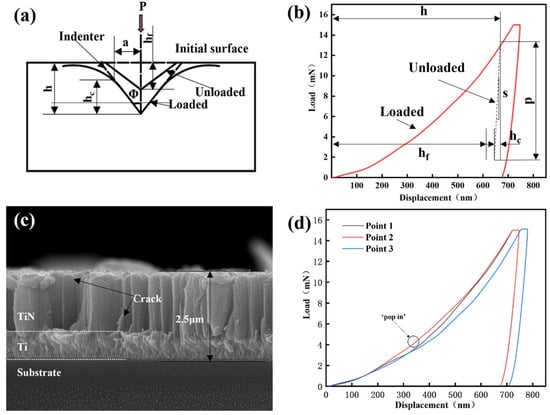
Figure 3.
(a) Schematic diagram of the nanoindentation process, (b) nanoindentation loading and unloading displacement curves, (c) cross-section of the DC-prepared TiN layer, (d) 3-point nanoindentation curve of the DC-sputtered TiN coating.
The hardness of the TiN layers manufactured with these parameters is significantly lower than that reported in other literature [,]. This low hardness is mainly due to cracks in the coating; the indenter is pressed into the coating under increasing normal force, and the coating is not deformed elastically in the beginning but deformed plastically with the expansion of cracks, or even cracked. The non-compactness of the coating leads to the creation of voids during the indentation, which also has a certain effect on the measurement results. TiN films prepared under RF source conditions are slightly improved in hardness compared with the DC source. During DC magnetron sputtering, the sputtering process is unstable due to the accumulation of charges on poorly conductive or non-conductive targets. However, by accelerating charged particles with an RF electric field, such a high-frequency electric field can generate an alternating electric field on the surface of the target material. So that even if it is a non-conductive target material, the surface will not accumulate an electric charge, thus achieving a stable sputtering process. Typically, ceramic targets are less conductive than some common metal targets, resulting in the higher performance of TiN coatings prepared by RF sputtering.
3.2. Effect of Ar Pressure on the Properties of TiN Coatings
Too high a working Ar pressure can lead to the presence of coarse grains within the coating, thus affecting its mechanical properties, while too low an Ar pressure makes it not easy to glow during the RF sputtering process. The group of experiments in S3 analyses the micro-morphology and mechanical properties of TiN coatings prepared by sputtering at 0.5 Pa. As the samples prepared under this condition and the other groups of experiments (S4, S5, S6, S7) were used as control groups for each other, the microscopic morphology maps and other property characterisation data are described and analysed in Section 3.3. To illustrate the effect of low and high pressure on the properties of the deposited coatings, Figure 4 shows the XRD and EDX spectrometry of TiN coatings prepared at different Ar pressure conditions of the RF source. The (111) peak is preferentially oriented in the TiN mixed peaks; the orientation of this peak is significantly enhanced at an Ar pressure of 0.5 Pa. Due to the lower surface energy, the diffraction peak of TiN (200) is also enhanced at a 2θ of 42.56°, which is closely related to the improvement in the mechanical properties of the coatings. Figure 4b shows that the atomic percentage of N/Ti is close to 1, which indicates that the coatings deposited using the TiN target have a more accurate stoichiometric ratio.
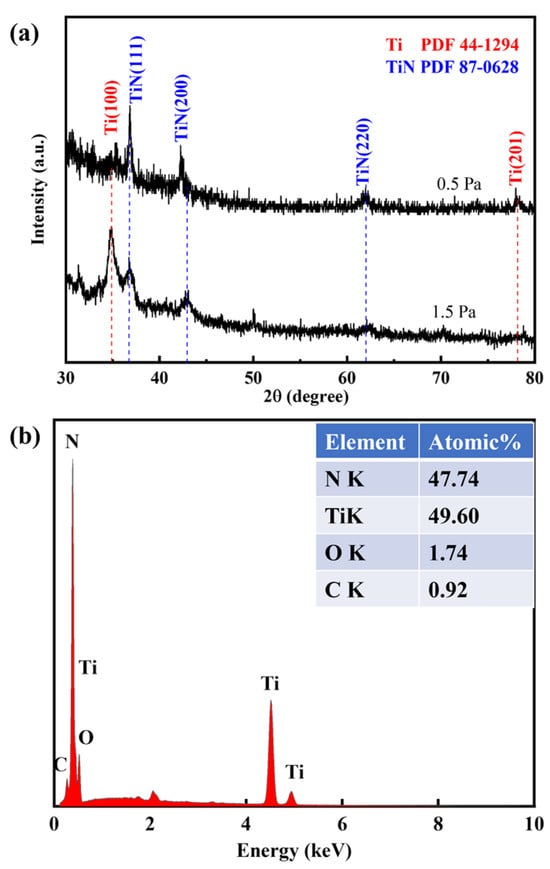
Figure 4.
(a) XRD patterns of TiN coatings prepared under different Ar pressure conditions; (b) chemical composition of little bit of TiN coating surface deposited at 0.5 Pa.
The hardness of TiN coatings deposited at a working Ar pressure of 0.5 Pa increased significantly. This significant increase in hardness is attributed to the increase in the density of the TiN coatings, which reduces the initial cracking and leads to a change in the residual stresses. The sputtered atoms or molecules on the substrate surface of adsorption capacity determines the coating performance. The adatoms initially adsorbed on the surface of the substrate will transiently migrate and exchange part of their energy with the substrate before the formation of steady-state atomic islands, and the internal stresses in the nucleation stage are mainly manifested as compressive stresses. Neighbouring atomic islands are fused with each other in the process of growth and diffusion and eventually form a continuous film, so the internal stress of the coating in this process is mainly tensile stress [].
When the Ar gas pressure is high, the sputtered target atoms are prone to collide with Ar atoms or other particles, resulting in the shortening of the mean free path. Their own energy is constantly being consumed, and they arrive at the substrate with low energy; films grown under these conditions are usually of low densities []. On the contrary, when the working air pressure is low, the sputtered atoms have a long mean free path. The nucleation density is high due to transient migration, the tensile stress is reduced in the process of the mutual integration of the atomic islands, and elevated compressive stresses result in a denser coating and therefore a significant increase in coating hardness [,,,].
3.3. Effect of Deposition Temperature on TiN Coatings
The five groups of samples, S3, S4, S5, S6 and S7, represent TiN films grown under the conditions of an RF power supply, Ar gas pressure of 0.5 Pa and sputtering substrate temperature of room temperature (25 °C), 100 °C, 200 °C, 300 °C and 400 °C, respectively. Figure 5 shows the surface and cross-section micro-morphology of the TiN coatings at different magnifications. The TiN coatings grown under five groups of different temperature conditions are dense and smooth, and the surfaces of the coatings deposited under conditions lower than 400 °C all show a ‘pyramidal’ morphology. All the cross-sections show obvious columnar structures, and the thickness of the coatings is basically the same, indicating that the temperature has little effect on the TiN deposition rate; these columnar structures have a clear demarcation line with the substrate. At the same time, the transition layer and the TiN layer become a mixed layer, but it can be seen that the surface of the Si substrate has a denser coating, which indicates the formation of a composite layer of TiN and Ti.
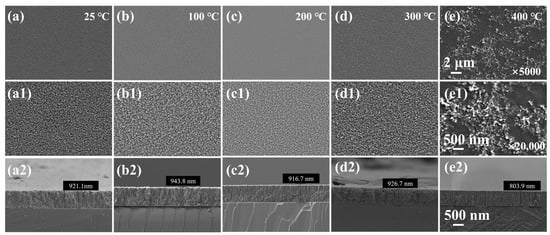
Figure 5.
Microscopic morphology of TiN coatings prepared at substrate temperatures of 25, 100, 200, 300 and 400 °C, with (a–e) magnifications of 5000×, (a1–e1) magnifications of 20,000× and (a2–e2) cross-section morphologies of the coatings.
Figure 6 shows the nanoindentation curves and hardness with standard deviation of TiN coatings deposited at different temperature conditions. The indentation loading curves for the conditions of 300 and 400 °C show more ‘pop in’ points; for the sake of accuracy, the number of indentation points for these two groups of experiments was five. Figure 6 shows that the hardness of the TiN coatings prepared at different temperatures is basically the same and slightly higher than 17 Gpa, indicating that the temperature has little effect on the hardness of TiN coatings, which is consistent with the results reported in the literature []. The stiffness or resistance to deformation of a coating can be quantified by Young’s modulus. The Young’s modulus of the TiN coatings prepared at 300 °C was the highest at 474.451 Gpa, which indicates that the coatings are difficult to deform and less ductile, while the Young’s modulus of the TiN coatings grown at 400 °C was 333.637 Gpa. Some literature regards the ratio of hardness to Young’s modulus as the ability of the material to resist elastic deformation and damage, while the value of H3/E2 is regarded as the resistance to plastic destruction [,], so that high values of H/E and H3/E2 represent the high toughness of the material. The experimental results of the S7 group show the highest H/E and H3/E2, which are 0.053 and 0.049 Gpa, respectively. Therefore, the film prepared at 400 °C has the best toughness, and the coating is not prone to deformation and overall peeling off when used as a cutting tool.
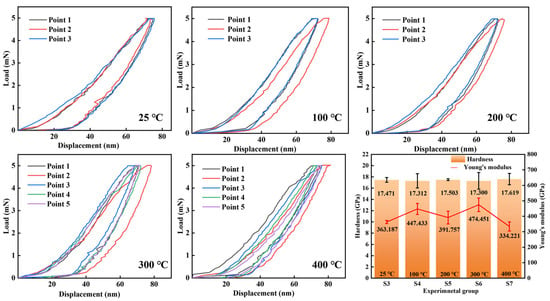
Figure 6.
Nanoindentation curves, hardness and Young’s modulus of TiN coatings deposited under different temperature conditions.
As a machining or moulding tool coating, its adhesion determines the tool’s service life, and the shedding failure of coated tools is one of the main failure forms. At present, there is no unified theoretical system about the adhesion of coatings. The main representatives are mechanical interlocking theory, diffusion theory, electrostatic theory, adsorption theory, chemical bonding theory, and these different theories are representative of different fields [,]. The mechanical interlocking effect can explain the phenomenon of the higher adhesion of coatings on rough surfaces, but it shows limitations as to the phenomenon of high adhesion on some polished mirror substrates. Diffusion theory can explain the phenomenon of the increased bonding force of coatings at higher temperatures. Figure 7a,b illustrate the evolution of scratch depth and acoustic signals between the coating and indenter under varying normal loads during the scratch testing process. At first, a maximum load of 50 mN is selected, and if the changes in scratch depth and acoustic signal are not obvious, the maximum load is increased to 100 mN, and so on. Combined with the optical micrographs in Figure 7c, it is possible to identify the failure point of the coating, which is followed by phenomena such as the coating peeling and substrate exposure. The normal force corresponding to the failure point of a coating prepared at room temperature is 40.64 mN, and similarly, the scratch load at the failure point at 100, 200, 300 and 400 °C is 43.81, 42.90, 64.13 and 42.07 mN, respectively. It can be concluded that TiN coatings prepared at 300 °C have the best adhesion.
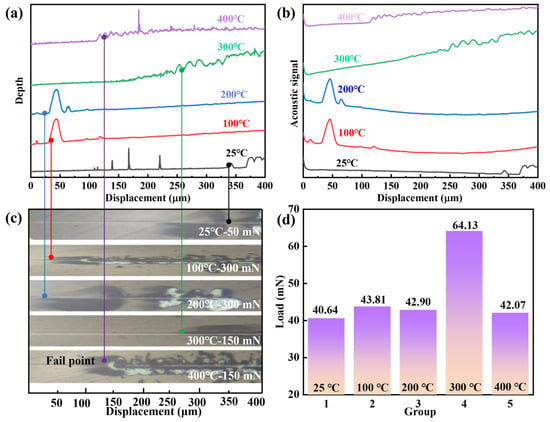
Figure 7.
Nano-scratch profiles of TiN coatings prepared at different temperature conditions, (a) scratch depth versus distance profile, (b) acoustic signal versus distance profile, (c) optical micro-morphology of scratches, (d) load corresponding to the coating failure point.
In general, a lower COF of the tool coating reduces the heat generated during the cutting process and improves machining efficiency, while contributing to the quality of workpiece processing. Figure 8 shows the calculated COF versus time curve for friction generated by the mutual motion between the friction partner of the pin-on-disc friction wear analyser and the TiN coating. There is a good linear relationship between the deposition temperature of TiN coatings and the COF, which maintains a decreasing trend as the temperature of the TiN layer increases. During the friction wear test, the COF has been kept in a small fluctuation range, which indicates that the TiN film has not yet reached the stage of severe wear. The COF between the TiN coatings and the friction partner made of Al2O3 is 0.67, 0.52, 0.48, 0.44 and 0.36 as the deposition temperature of the TiN coating increases, respectively. The coating deposited with a TiN target has a lower COF as compared to TiN coatings prepared by reactive magnetron sputtering [].
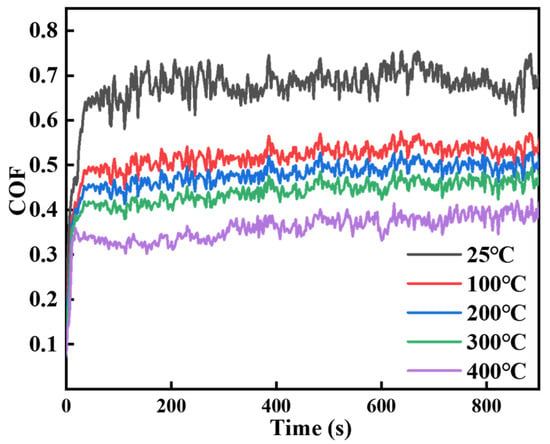
Figure 8.
Coefficient of friction of TiN coatings deposited at different temperatures.
TiN coatings deposited at 400 °C have the best toughness and lowest COF; however, the bonding between TiN coatings and cemented carbide is best at 300 °C. Figure 9a shows the XRD patterns of TiN coatings deposited at different temperatures. It is noteworthy that the peak of (220) decreases significantly at 400 °C, and the preferred orientation of (220) indicates that the energy injected into the particles is sufficiently high for the TiN crystals to predominantly exhibit a trigonal structure at this point. Thus, the weakening of the (220) orientation predicts the disappearance of the ‘pyramidal’ morphology, which can also be observed from Figure 5e. A ‘pyramidal’ structure provides higher adhesion due to the mechanical interlocking relationship, whereas the reason for the lower coating bonding at 400 °C may be related to the disappearance of the pyramidal morphology. When the deposition temperature was varied between 25 and 400 °C, the (200) peak remained strongly orientated, which is related to the mechanical properties of the coatings, and this is the reason why the hardness of the coatings remained at 17 GPa (Figure 6). The intensity of the (111) peak first enhances and then decreases with increasing temperatures. The orientation of (111) has a strong influence on the coating roughness, which may be responsible for the variation in the coating’s COF.
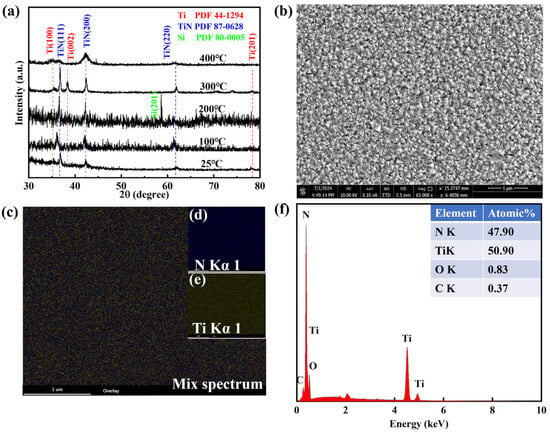
Figure 9.
(a) XRD patterns of TiN coatings deposited at different temperature conditions, (b) analysing regions of elemental composition, (c–f) characteristic elements X-ray mapping and EDX spectra of TiN samples prepared at 400 °C.
At the same time, the deposition temperature affects the nucleation and growth process of the coating. Figure 9b–f show the EDX scanned area with elemental composition of a TiN coating deposited at 400 °C. The diffusion of Ti atoms in the transition layer may have led to a decreasing trend in the percentage of N to Ti atoms. The role of the transition layer is to avoid the substrate and hard coating due to the difference in physical properties, and excessive interfacial effects lead to a delamination of the coating in the action of shear. Therefore, depositing some coatings between the hard coat and the substrate with coefficients of thermal expansion, linear densities and other physical properties intermediate to those of the film substrate can mitigate lattice mismatches and energy differences at the interface. The ability of atoms to diffuse and migrate is related to the deposition temperature. When the deposition temperature is high, the Ti atoms in the sandwich material can easily migrate between the substrate and the surface of the TiN layer to fill the coating’s voids and eliminate defects, which contributes to the improvement in coating adhesion. However, too high a deposition temperature may also lead to transition diffusion, making the interfacial region unstable. As a result, the coating adhesion is better for coatings deposited at 300 °C and decreases at 400 °C. The diffusion of Ti as a ductile interlayer also leads to an elevated toughness of the TiN layer []. At the same time, the diffusion of Ti atoms acts as a solid lubricant, and changes in compressive residual stresses due to changes in deposition temperature also have an important effect on the mechanical properties of the coatings [,].
4. Conclusions
TiN coatings with a Ti interlayer were deposited on cemented carbide substrates via magnetron sputtering using a stoichiometric TiN target. The structure and mechanical properties of the coatings were systematically investigated under varying process parameters. The key findings include the following: (i) DC-sputtered TiN coatings exhibited cluster-like grains with numerous initial cracks on the surface, while RF-sputtered coatings featured pyramidal-shaped grains. Both the DC and RF sputtering processes yielded a preferred (111) orientation in the TiN mixed-phase diffraction peaks. (ii) Reducing the working gas pressure significantly enhanced the nano-hardness of the films to over 17 GPa, albeit at the expense of a decreased sputtering rate. (iii) Nano-scratch tests revealed that TiN films deposited at 300 °C achieved optimal adhesion, with a critical fracture load of 64 mN. The coefficient of friction (COF) decreased with increasing deposition temperatures, reaching a minimum value of 0.36 at 400 °C. The influence mechanisms of the aforementioned deposition parameters on the thin film properties were thoroughly analysed. Notably, TiN films sputtered directly from the synthetic TiN target demonstrated superior stoichiometric control and a lower COF compared to their reactively sputtered counterparts, thereby establishing their dominance in high-precision tribological applications.
Supplementary Materials
The following supporting information can be downloaded at: https://www.mdpi.com/article/10.3390/coatings15030329/s1, Figure S1: TiN coatings prepared at RF 1.5 Pa, (a) cross-sectional morphology of the coatings, (b) nanoindentation profile of TiN coatings prepared by RF power supply.
Author Contributions
Conceptualisation, H.Q. and Y.W.; Data curation, M.L.; Funding acquisition, H.Q.; Investigation, Y.W., M.L., Z.W. and W.W.; Methodology, Y.W. and M.L.; Software, X.X. and Y.X.; Writing—original draft, M.L.; Writing—review and editing, Y.W. All authors have read and agreed to the published version of the manuscript.
Funding
This work was financially supported by the Innovation Capability Support Program of Shaanxi (No. 2024CX-GXPT-21), Key R & D plan of Shaanxi Province (No. 2023-YBGY-097), Shaanxi Science and Technology Resources Open Sharing Platform (No. 2022PT-02).
Institutional Review Board Statement
Not applicable.
Informed Consent Statement
Not applicable.
Data Availability Statement
Data are contained within the article.
Conflicts of Interest
The authors declare no conflict of interest.
References
- Subhedar, D.G.; Chauhan, K.V.; Patel, D.A. An experimental investigation of TiN coating on cutting force and surface finish in milling of aluminium. Mater. Today Proc. 2022, 59, 161–165. [Google Scholar] [CrossRef]
- Chang, C.-L.; Lo, K.-C.; Yang, F.-C.; Shen, G.-L.; Tang, J.-F. HiPIMS co-sputtering for the increase of the mechanical properties of arc deposited TiN coatings. J. Mater. Res. Technol. 2023, 26, 2050–2059. [Google Scholar] [CrossRef]
- Klocke, F.; Krieg, T. Coated Tools for Metal Cutting–Features and Applications. CIRP Ann. 1999, 48, 515–525. [Google Scholar] [CrossRef]
- Xian, G.; Xiong, J.; Fan, H.; Jiang, F.; Guo, Z.; Zhao, H.; Xian, L.; Jing, Z.; Liao, J.; Liu, Y. Investigations on microstructure, mechanical and tribological properties of TiN coatings deposited on three different tool materials. Int. J. Refract. Met. Hard Mater. 2022, 102, 105700. [Google Scholar] [CrossRef]
- Dubar, M.; Dubois, A.; Dubar, L. Wear analysis of tools in cold forging: PVD versus CVD TiN coatings. Wear 2005, 259, 1109–1116. [Google Scholar] [CrossRef]
- von Fieandt, L.; Larsson, T.; Lindahl, E.; Bäcke, O.; Boman, M. Chemical vapor deposition of TiN on transition metal substrates. Surf. Coat. Technol. 2018, 334, 373–383. [Google Scholar] [CrossRef]
- Das, S.; Guha, S.; Ghadai, R.; Sharma, A. Influence of nitrogen gas over microstructural, vibrational and mechanical properties of CVD Titanium nitride (TiN) thin film coating. Ceram. Int. 2021, 47, 16809–16819. [Google Scholar] [CrossRef]
- Miao, J.; Song, J.; Xue, Y.; Tong, Y.; Tang, W.; Lu, F. Effect of a two-step pretreatment method on adhesion of CVD diamond coatings on cemented carbide substrates. Surf. Coat. Technol. 2004, 187, 33–36. [Google Scholar] [CrossRef]
- Kumar, A.; Mulik, R.S. Improving tribological behavior of titanium nitride (TiN) hard coatings via zirconium (Zr) or vanadium (V) doping. Tribol. Int. 2023, 189, 108997. [Google Scholar] [CrossRef]
- Teyssandier, F.; Allendorf, M.D. Thermodynamics and Kinetics of Gas-Phase Reactions in the Ti-Cl-H System. J. Electrochem. Soc. 2019, 145, 2167–2178. [Google Scholar] [CrossRef]
- Zeng, Y.; Qiu, Y.; Mao, X.; Tan, S.; Tan, Z.; Zhang, X.; Chen, J.; Jiang, J. Superhard TiAlCN coatings prepared by radio frequency magnetron sputtering. Thin Solid Film 2015, 584, 283–288. [Google Scholar] [CrossRef]
- Zhang, X.; Qiu, Y.; Tan, Z.; Lin, J.; Xu, A.; Zeng, Y.; Moore, J.J.; Jiang, J. Effect of Al content on structure and properties of TiAlCN coatings prepared by magnetron sputtering. J. Alloys Compd. 2014, 617, 81–85. [Google Scholar] [CrossRef]
- Saoula, N.; Bait, L.; Sali, S.; Azibi, M.; Hammouche, A.; Madaoui, N. Reactive Magnetron Sputter Deposition of Titanium Oxynitride TiNxOy Coatings: Influence of Substrate Bias Voltage on the Structure, Composition, and Properties. Prot. Met. Phys. Chem. Surf. 2019, 55, 743–747. [Google Scholar] [CrossRef]
- Richter, N.A.; Yang, B.; Barnard, J.P.; Niu, T.; Sheng, X.; Shaw, D.; Watanabe, M.; Rane, G.; Krause, U.; Dürrenfeld, P.; et al. Significant texture and wear resistance improvement of TiN coatings using pulsed DC magnetron sputtering. Appl. Surf. Sci. 2023, 635, 157709. [Google Scholar] [CrossRef]
- Kataria, S.; Srivastava, S.K.; Kumar, P.; Srinivas, G.; Siju; Khan, J.; Rao, D.V.S.; Barshilia, H.C. Nanocrystalline TiN coatings with improved toughness deposited by pulsing the nitrogen flow rate. Surf. Coat. Technol. 2012, 206, 4279–4286. [Google Scholar] [CrossRef]
- Vaz, F.; Ferreira, J.; Ribeiro, E.; Rebouta, L.; Lanceros-Méndez, S.; Mendes, J.A.; Alves, E.; Goudeau, P.; Rivière, J.P.; Ribeiro, F.; et al. Influence of nitrogen content on the structural, mechanical and electrical properties of TiN thin films. Surf. Coat. Technol. 2005, 191, 317–323. [Google Scholar] [CrossRef]
- Zhou, T.; Liu, D.; Zhang, Y.; Ouyang, T.; Suo, J. Microstructure and hydrogen impermeability of titanium nitride thin films deposited by direct current reactive magnetron sputtering. J. Alloys Compd. 2016, 688, 44–50. [Google Scholar] [CrossRef]
- Shuai, J.; Zuo, X.; Wang, Z.; Guo, P.; Xu, B.; Zhou, J.; Wang, A.; Ke, P. Comparative study on crack resistance of TiAlN monolithic and Ti/TiAlN multilayer coatings. Ceram. Int. 2020, 46, 6672–6681. [Google Scholar] [CrossRef]
- Tien, S.-K.; Lin, C.-H.; Tsai, Y.-Z.; Duh, J.-G. Oxidation behavior, microstructure evolution and thermal stability in nanostructured CrN/AlN multilayer hard coatings. J. Alloys Compd. 2010, 489, 237–241. [Google Scholar] [CrossRef]
- Huang, Y.; Chen, Z.; Wagner, A.; Mitterer, C.; Song, K.; Zhang, Z. High density of stacking faults strengthened TaN/TiN multilayer. Acta Mater. 2023, 255, 119027. [Google Scholar] [CrossRef]
- Fallmann, M.; Chen, Z.; Zhang, Z.L.; Mayrhofer, P.H.; Bartosik, M. Mechanical properties and epitaxial growth of TiN/AlN superlattices. Surf. Coat. Technol. 2019, 375, 1–7. [Google Scholar] [CrossRef]
- Li, H.; Liu, Y.; Jiang, B.; Kan, J.; Liu, Z. The structure and toughness of TiN coatings prepared by modulated pulsed power magnetron sputtering. Vacuum 2016, 125, 165–169. [Google Scholar] [CrossRef]
- Arudi, I.S.; Hamzah, E.; Yajid, M.A.M.; Bushroa, A.R.; Munshi, S.M.; Al-Ashhab, M.S.; Ibrahim, M.Z. Taguchi optimization of hardness and scratch adhesion strength of multilayer Ti/TiN coatings on Ti- 51 at%Ni alloy deposited via magnetron sputtering technique. J. Mater. Res. Technol. 2023, 27, 7664–7672. [Google Scholar] [CrossRef]
- Pei, Y.T.; Galvan, D.; De Hosson, J.T.M. Nanostructure and properties of TiC/a-C:H composite coatings. Acta Mater. 2005, 53, 4505–4521. [Google Scholar] [CrossRef]
- Bräuer, G.; Szyszka, B.; Vergöhl, M.; Bandorf, R. Magnetron sputtering–Milestones of 30 years. Vacuum 2010, 84, 1354–1359. [Google Scholar] [CrossRef]
- Yuan, Z.; Han, Y.; Zang, S.; Chen, J.; He, G.; Chai, Y.; Yang, Z.; Fu, Q. Damage evolution behavior of TiN/Ti multilayer coatings under high-speed impact conditions. Surf. Coat. Technol. 2021, 426, 127807. [Google Scholar] [CrossRef]
- Castanho, J.M.; Vieira, M.T. Effect of ductile layers in mechanical behaviour of TiAlN thin coatings. J. Mater. Process. Technol. 2003, 143–144, 352–357. [Google Scholar] [CrossRef]
- Fu, Z.; Koc, R. Nanoindentation mechanical properties of TiB2-TiC-TiNiFeCrCoAl high-entropy alloys cermet: A comparison study with WC-Co. Int. J. Refract. Met. Hard Mater. 2021, 98, 105564. [Google Scholar] [CrossRef]
- Braic, M.; Zoita, N.C.; Danila, M.; Grigorescu, C.E.A.; Logofatu, C. Hetero-epitaxial growth of TiC films on MgO(001) at 100 °C by DC reactive magnetron sputtering. Thin Solid Film 2015, 589, 590–596. [Google Scholar] [CrossRef]
- Qi, Q.; Zhang, W.Z.; Shi, L.Q.; Zhang, W.Y.; Zhang, W.; Zhang, B. Preparation of single-crystal TiC (111) by radio frequency magnetron sputtering at low temperature. Thin Solid Film 2012, 520, 6882–6887. [Google Scholar] [CrossRef]
- Veprek, S.; Karvankova, P.; Veprek-Heijman, M.G.J. Possible role of oxygen impurities in degradation of nc-TiN∕a-Si3N4 nanocomposites. J. Vac. Sci. Technol. B Microelectron. Nanometer Struct. Process. Meas. Phenom. 2005, 23, L17–L21. [Google Scholar] [CrossRef]
- Oliver, W.C.; Pharr, G.M. An improved technique for determining hardness and elastic modulus using load and displacement sensing indentation experiments. J. Mater. Res. 2011, 7, 1564–1583. [Google Scholar] [CrossRef]
- Yu, H.Z.; Thompson, C.V. Grain growth and complex stress evolution during Volmer–Weber growth of polycrystalline thin films. Acta Mater. 2014, 67, 189–198. [Google Scholar] [CrossRef]
- Kumar, M.; Mitra, R. Effect of substrate temperature and annealing on structure, stress and properties of reactively co-sputtered Ni-TiN nanocomposite thin films. Thin Solid Film 2017, 624, 70–82. [Google Scholar] [CrossRef]
- Pao, C.-W.; Srolovitz, D.J. Stress and Morphology Evolution during Island Growth. Phys. Rev. Lett. 2006, 96, 186103. [Google Scholar] [CrossRef]
- Patro, S.S.; Sahoo, A.K.; Roy, S. Analysis of residual stresses in cutting tools coated via physical vapour deposition: A review. Mater. Today Proc. 2023. [Google Scholar] [CrossRef]
- Romano-Brandt, L.; Salvati, E.; Le Bourhis, E.; Moxham, T.; Dolbnya, I.P.; Korsunsky, A.M. Nano-scale residual stress depth profiling in Cu/W nano-multilayers as a function of magnetron sputtering pressure. Surf. Coat. Technol. 2020, 381, 125142. [Google Scholar] [CrossRef]
- Vierneusel, B.; Schneider, T.; Tremmel, S.; Wartzack, S.; Gradt, T. Humidity resistant MoS2 coatings deposited by unbalanced magnetron sputtering. Surf. Coat. Technol. 2013, 235, 97–107. [Google Scholar] [CrossRef]
- Li, X.; Li, G.; Lü, W.; Liu, S.; Li, C.; Wang, Q. Controllable high adhesion and low friction coefficient in TiAlCN coatings by tuning the C/N ratio. Appl. Surf. Sci. 2022, 597, 153542. [Google Scholar] [CrossRef]
- Tillmann, W.; Grisales, D.; Stangier, D.; Thomann, C.-A.; Debus, J.; Nienhaus, A.; Apel, D. Residual stresses and tribomechanical behaviour of TiAlN and TiAlCN monolayer and multilayer coatings by DCMS and HiPIMS. Surf. Coat. Technol. 2021, 406, 126664. [Google Scholar] [CrossRef]
- Bai, Y.; Xi, Y.; Gao, K.; Yang, H.; Pang, X.; Volinsky, A.A. Residual stress control in CrAlN coatings deposited on Ti alloys. Ceram. Int. 2018, 44, 4653–4659. [Google Scholar] [CrossRef]
- Escobar, D.; Ospina, R.; Gómez, A.G.; Restrepo-Parra, E. Microstructure, residual stress and hardness study of nanocrystalline titanium–zirconium nitride thin films. Ceram. Int. 2015, 41, 947–952. [Google Scholar] [CrossRef]
Disclaimer/Publisher’s Note: The statements, opinions and data contained in all publications are solely those of the individual author(s) and contributor(s) and not of MDPI and/or the editor(s). MDPI and/or the editor(s) disclaim responsibility for any injury to people or property resulting from any ideas, methods, instructions or products referred to in the content. |
© 2025 by the authors. Licensee MDPI, Basel, Switzerland. This article is an open access article distributed under the terms and conditions of the Creative Commons Attribution (CC BY) license (https://creativecommons.org/licenses/by/4.0/).